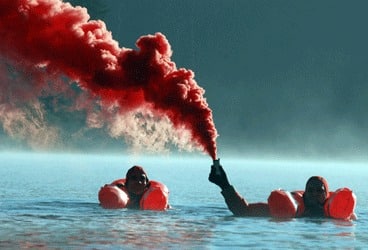
Strobe Lights and Rescue Odds
“Being found is about being seen, right?” Molthen asks, reminding me of cases where we flew directly over people – several times – whom we didn’t see. Despite the newest infrared and night vision technologies, it can be extremely difficult to see something as small as a raft, or just a person, in the vast ocean. Nick Schuyler, the lone survivor of a capsizing off Florida’s Gulf Coast, recently co-wrote the book Not Without Hope. In it, he describes how he and former NFL defensive end Corey Smith waved their life jackets at several passing search aircraft without ever being seen. A U.S. Coast Guard cutter finally spotted Schuyler, sitting on the hull of the overturned boat, after Smith and two others had died.
“Especially at night, if you don’t have a light of some kind or reflective tape on, we won’t be able to see you,” Molthen says. Strobe lights are best because they can last for hours and are easily mounted on life jackets and survival suits, “but you can’t go wrong with a spare,” he says. “Or two.”
Often, it’s nothing more than a small lamp, lighters or a flashlight that cuts through the night and leads rescuers to a survivor on the open ocean. Schuyler desperately tried taking pictures with his cell phone, hoping the flash would be enough. It wasn’t.
My opinion about the importance of carrying strobes and flashlights was solidified during the final moments of a search in the bayous of Louisiana. I spotted a boater only after he lit his own life jacket on fire and waved it over his head. He said we’d flown over him all night without seeing him wave, so he broke out his lighter and took the risk.
When to Fire Your Flares
If you have flares, consider who might be able to see your signal before launching. Search planes rarely (if ever) have anyone looking behind them. You can launch a flare if you see a flashing light in the sky, but wait until you see a red or green nav light – or both – and your chances of being seen go way up. Remember that aircraft and boats always search in a grid pattern of one kind or another. After searching in one direction, they move over a tenth or quarter of a mile and search again in an opposing direction. Wait for that return leg to ensure rescuers have you in their windows before launching that last flare.
At night, your “last flare” might not be your last. The day end of day/night flares puts out more than just orange smoke. It puts out very hot orange smoke, which is highly visible on the infrared equipment aboard search aircraft. And all crews fly with night vision goggles. The smoke catches the ambient light, making it almost as visible with those goggles at night as it is to the naked eye during the day.
With all flares, be careful to point them downwind and hold them out over the water. Handheld flares may drip hot phosphorous that can burn holes in your life jacket or life raft.
When to Stop Signaling
How do you know a search aircraft or ship has seen you? It stays.
Personnel in a fixed-wing aircraft will be relaying your position while a coordination center arranges the rescue, but they aren’t going to leave the scene as long as they have fuel. If they do need to leave, they will wait for a relief aircraft if possible. If a helicopter crew spots you, they will mark your position, pass the information along and move in to pick you up within minutes.
Of course, you’ll do everything you can to handle an at-sea emergency before it gets out of control, and so far you’ve probably done a good job of staying safe out there. But look around your boat now, before an emergency arises. Survival gear is aboard for a reason. If things go bad and you don’t think your boat will make it home, then consider all your options and use the gear you never thought you’d need.
And don’t look so surprised. It happens all the time.
* * * * *
The U.S. Coast Guard is asking all boat owners and operators to help reduce fatalities, injuries, property damage, and associated healthcare costs related to recreational boating accidents by taking personal responsibility for their own safety and the safety of their passengers. Essential steps include: wearing a life jacket at all times and requiring passengers to do the same; never boating under the influence (BUI); successfully completing a boating safety course; and getting a Vessel Safety Check (VSC) annually from local U.S. Coast Guard Auxiliary, United States Power Squadrons(r), or your state boating agency’s Vessel Examiners. The U.S. Coast Guard reminds all boaters to “Boat Responsibly!” For more tips on boating safety, visit www.uscgboating.org.








